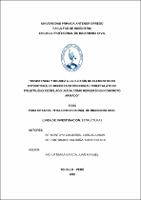Mostrar el registro sencillo del ítem
Resistencia y rigidez a la flexión de elementos no estructurales reforzado con fibras tereftalato de polietileno reciclado usada como refuerzo en concreto armado.
| dc.contributor.advisor | Urteaga García, Juan Manuel | |
| dc.contributor.author | Montoya Calderón, Carlos Junior | |
| dc.contributor.author | Tantaraico Saldaña, Ever Renulfo | |
| dc.creator | Montoya Calderón, Carlos Junior | |
| dc.date.accessioned | 2019-05-06T21:15:56Z | |
| dc.date.available | 2019-05-06T21:15:56Z | |
| dc.date.issued | 2019 | |
| dc.identifier.other | T046_45759482_T | |
| dc.identifier.other | T046_47329533_T | |
| dc.identifier.uri | https://hdl.handle.net/20.500.12759/4766 | |
| dc.description.abstract | En la presente investigación se logró determinar los resultados de reutilizar los residuos de plástico PET, como refuerzo en la elaboración de concreto ecológico para la construcción de elementos no estructurales. Se utilizó como materia prima, para el diseño de mezclas, el cemento Portland Extra Forte, piedra chancada de 1/2“, arena gruesa y como refuerzo las fibras de plástico PET, estos residuos sustituyeron al acero corrugado en forma de sogas trenzadas de 6 hebras y 6 almas en variaciones de 1, 2 y 3 respectivamente. Se elaboraron 15 muestras (vigas) de 15x15x120cm, reforzadas con fibras PET trenzado 5 muestras se reforzaron con 1 fibra PET, 5 con 2 fibras PET y 5 con 3 fibras PET. Luego de 28 días debidamente curados dichas vigas se realizó la prueba a la flexión teniendo en cuenta la Norma Técnica Peruana 339.079. Donde se obtuvo resultados de las 15 muestras, dichos resultados fueron tabulados para graficar su comportamiento de cada elemento (diagrama momento curvatura) y posteriormente calcular su módulo de rotura, rigidez y cuantía mínima de refuerzo con fibras PET en el concreto armado. Así mismo se elaboraron probetas del mismo concreto utilizado para las vigas, por un tema netamente de control de calidad según la Norma Técnica Peruana 339.033, luego se realizó el ensayo de compresión a las probetas, después de 7, 14 y 28 días según la Norma ASTM C39, con lo cual se pudo determinar la resistencia a la compresión del concreto. Para conocer sus características y comportamiento de las fibras PET trenzadas se realizó la prueba de tensión obteniendo la curva de esfuerzo deformación. | es_PE |
| dc.description.abstract | In this research it was achieved to determine the results of re-using the residues of plastic PET, as reinforcement in the production of ecological concrete for the construction of non-structural elements. There used as raw material, for the design of mixtures, the Portland Extra Forte cement, ground stone of 1/2 “, thick sand and as an enhancement the fibers of plastic PET, these residues substituted the corrugated steel in shape of plaited ropes of 6 fibers and 6 souls in variations of 1, 2 and 3 respectively. There were elaborated 15 samples (girders) of 15x15x120cm, reinforced with PET fibers plaited 5 samples were reinforced by 1 PET fiber, 5 by 2 PET fibers and 5 by 3 PET fibers. After 28 properly cured days those girders, the test was performed to the flexion taking into account the Peruvian technical norm 339.079. Where it was obtained the results from 15 samples, those results were tabulated to plot the behavior of each element (graph moment curvature) and later to calculate its module of break, rigidity and minimal quantity of reinforcement with PET fibers in the structured concrete. Likewise there were elaborated manometers of the same concrete used for the girders, just for the quality control according to the Peruvian Technical Norm 339.033, then the compression test was carried out to the manometers, after 7, 14 and 28 days according to the Norm ASTM C39, with that it was possible to determine the resistance of the compression of the concrete. To know its characteristics and behavior of the PET plaited fibers, it was performed the test of tension obtaining the curve of effort deformation. | en_US |
| dc.description.uri | Tesis | es_PE |
| dc.format | application/pdf | es_PE |
| dc.language.iso | spa | es_PE |
| dc.publisher | Universidad Privada Antenor Orrego | es_PE |
| dc.relation.ispartofseries | T_ING.CIVIL_1705 | |
| dc.rights | info:eu-repo/semantics/openAccess | es_PE |
| dc.rights.uri | https://creativecommons.org/licenses/by/4.0/ | es_PE |
| dc.source | Universidad Privada Antenor Orrego | es_PE |
| dc.source | Repositorio Institucional - UPAO | es_PE |
| dc.subject | Concreto ecológico | es_PE |
| dc.subject | Residuos de plástico PET | es_PE |
| dc.subject | Elementos no estructurales | es_PE |
| dc.subject | Concreto armado | es_PE |
| dc.title | Resistencia y rigidez a la flexión de elementos no estructurales reforzado con fibras tereftalato de polietileno reciclado usada como refuerzo en concreto armado. | es_PE |
| dc.type | info:eu-repo/semantics/bachelorThesis | es_PE |
| thesis.degree.level | Título Profesional | es_PE |
| thesis.degree.grantor | Universidad Privada Antenor Orrego. Facultad de Ingeniería | es_PE |
| thesis.degree.name | Ingeniero Civil | es_PE |
| thesis.degree.discipline | Ingeniería Civil | es_PE |
| dc.subject.ocde | https://purl.org/pe-repo/ocde/ford#2.01.00 | |
| renati.type | https://purl.org/pe-repo/renati/type#tesis | |
| renati.level | https://purl.org/pe-repo/renati/level#tituloProfesional | |
| dc.publisher.country | PE | es_PE |
Ficheros en el ítem
Este ítem aparece en la(s) siguiente(s) colección(es)
-
Ingeniería Civil [1260]


